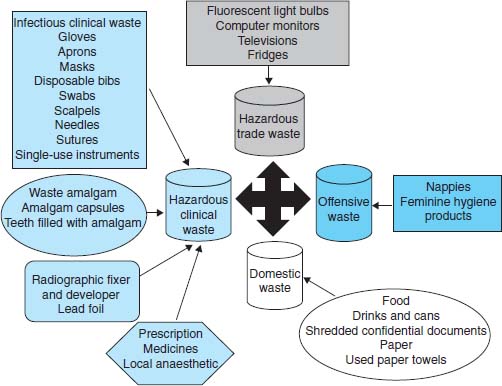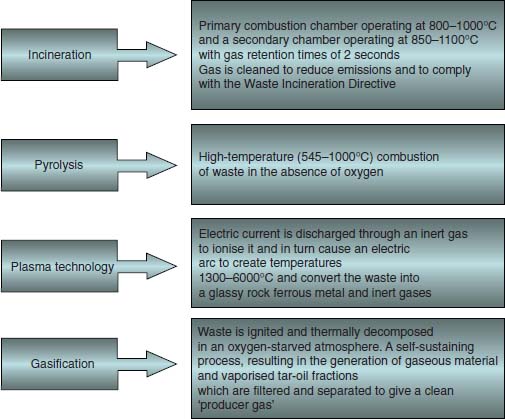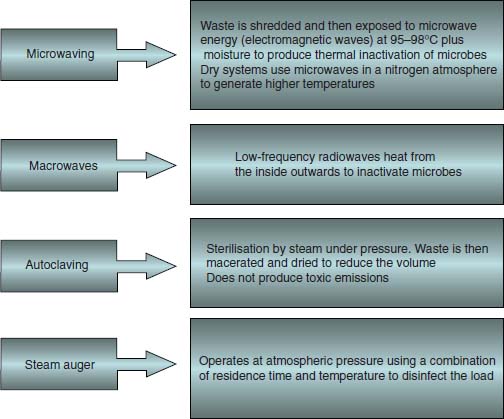Chapter 10
Health care waste management
LEGISLATION ON HAZARDOUS WASTE DISPOSAL
The primary message in all European Union waste management strategies is to manage waste sustainably by:
- Reducing the volume of waste produced per capita
- Limiting the number of landfill sites
- Protecting the environment from pollution by hazardous effluents
This ‘green’ approach to clinical waste is reflected in national legislation (Hazardous Waste Regulations 2005 and List of Waste Regulations 2005). Under the current regulations, the dentist and the dental practice is defined as a waste ‘producer’. The dentist, therefore, has full responsibility and a duty of care for ensuring that waste is segregated, transported and disposed of according to national and international guidelines. As an employer, the dentist is responsible for protecting all members of their dental team, patients and waste disposal contractors from accidental exposure to hazardous waste. All members of the dental team can make a contribution to protecting the environment by reducing the amount of unnecessary waste and recycling waste whenever possible.
On a practical level, each dental practice is required to prepare its own waste policy and to identify which member(s) of the staff are responsible for overseeing the local management of health care waste including:
- Segregation of hazardous from non-hazardous waste streams
- Handling and on-site storage
- Waste collection
- Record keeping
Fortunately, in the UK, the dentist is guided through this complex web of legislation by a code of practice entitled ‘Environment and Sustainability HTM 07-01: Safe Management of Health Care Waste – 2006’. The key features of the code of practice are outlined in Box 10.1.
- The regulator (Environment Agency in the UK) has adopted a ‘unified’ approach for consigning hazardous infectious and medicinal waste that is complicit with the health and safety, transport and waste regulations
- Dentists as producers of health care waste have a duty of care to ensure that all health care waste is managed and disposed of properly
- It is a legal requirement in England and Wales for waste producers to segregate hazardous and non-hazardous waste at source since it is no longer permissible to dispose of hazardous and non-hazardous material at the same landfill site
- Transfer and consignment notes must contain a written description of the waste and the appropriate EWC codes
- Producers (consignors) of hazardous waste must notify their premises to the Environment Agencya. A dental premise is exempted from notification if it produces <200 kg of hazardous waste material per year (which includes hazardous non-clinical items such as fridges, TVs, computer screens) and the hazardous waste is removed from the premises by a registered carrier
- Movement of hazardous waste from premises that are not either notified (registered) or exempted is prohibited; in doing so a criminal offence is committed
- Each dental premise producing waste is assigned a unique six-digit premise reference code that is used to identify and track the movement of the waste
- Owners of multiple practices are required to register each practice separately
- The producer must ensure that the waste falls within the terms of the waste contractor’s waste management licence, permit or exemption
- The producer must keep transfer notes from the waste carrier for 2 years and consignment notes and returns from waste disposal contractor for 3 years
Modified from Code of Practice ‘Environment and sustainability HTM 07-01: Safe management of health care waste – 2006’.
EWC, European waste catalogue.
a In Northern Ireland, the waste producer must pre-notify the Environment and Heritage service prior to each collection and movement of hazardous waste. In England and Wales, dental premises are registered with the regulator on annual basis.
TYPES OF WASTE
Most dental practices will generate four main types of waste (see Figure 10.1):
- Clinical waste
- Medicines waste
- ‘Offensive’ waste
- Trade waste
Figure 10.1 Dental health care waste streams.

The remainder of this chapter will focus on the disposal of waste generated by clinical treatment. For information on the disposal of trade and domestic waste or recycling, please refer to the Department for Environment, Food, and Rural Affairs and Environment Agency websites listed at the end of the chapter.
WHAT IS HAZARDOUS WASTE?
A hazardous waste is a waste with one or more properties that are hazardous to health or the environment, e.g. explosive, oxidising, highly flammable, flammable, irritant, infectious, toxic, carcinogenic, teratogenic, mutagenic, harmful, toxic gases and ecotoxic.
- Human or animal tissue
- Blood or bodily fluid
- Excretions
- Drugs or other pharmaceutical products
- Swabs or dressings
- Syringes, needles or other sharp instruments
- Any other waste arising from dentistry which may cause infection or unless rendered safe may prove hazardous to any person coming into contact with it
Clinical waste as defined in Box 10.2 is categorised as a hazardous waste. Prior to disposal in landfill sites, the traditional method for reducing the volume and mass of clinical waste and making it safe has been incinerated. But a burgeoning body of evidence has questioned the efficacy and safety of incineration. Of particular concern is pollution from exhaust emissions, especially when incinerators are located in residential or environmentally sensitive areas. For instance, viable bacteria can be released from exhaust flues under certain circumstances. Temperature gradients form in the incinerator exhaust stack and pathogenic bacteria can survive in the cooler zones at the base of the stack. These and similar concerns have prompted the introduction of more reliable and environment-friendly disinfection methods referred to collectively as ‘alternative technology methods’ which employ heat, chemicals or irradiation.
Heat processes can be divided into high- and low-temperature methods (Figures 10.2 and 10.3).
All of these processes are intended to render the waste non-hazardous, unrecognisable and acceptable for landfill. In general, alternative technology methods operate at lower temperatures than those generated during incineration. For example, microwaving exposes the waste to temperatures in the range of 95–98°C and is deemed unsuitable for wastes containing metal objects, body parts, toxic chemicals and radioactive substances. So, it is essential that the waste disposal contractor is made aware of the exact contents of the sharps receptacle (bin) so that the waste is treated using the appropriate process. Approximately, 95% of clinical waste produced in hospitals can be effectively treated with alternative technology processes. Notable exceptions include infectious waste containing Variant Creutzfeldt–Jakob disease, cytotoxic medicines, large metallic objects and anatomical waste which will require incineration. Once a waste is rendered free of infection using any of these methods, then it is no longer considered to be hazardous.
Figure 10.2 High-temperature processes.

HAZARDOUS WASTE REGULATIONS AND THE EUROPEAN WASTE CATALOGUE CODE
According to the Hazardous Waste Regulations 2005, the dentist is legally obliged to segregate and consign, i.e. label waste for collection with a brief written description of the waste and the appropriate EWC (European waste catalogue) code. Developed by the European Commission and applicable across all the states of the European Union, the EWC (2002) code classifies individual waste products under 20 main chapter headings that are linked to an industrial sector. Each type of waste product is assigned a six-digit code. Hazardous waste is marked with asterisk (*) after the code number. The chapters applicable to dental health care waste are Chapter 18 of the EWC for the waste from natal care, diagnosis, treatment or prevention of diseases in humans (see Table 10.1) and Chapters 9 and 15 of the EWC for the consignment of X-ray fixer and developer.
Figure 10.3 Alternative non-burn and low-temperature processes.

Infectious clinical waste
According to the guidance set down in the code of practice, the dentist would be expected to perform a task-based risk />
Stay updated, free dental videos. Join our Telegram channel

VIDEdental - Online dental courses


